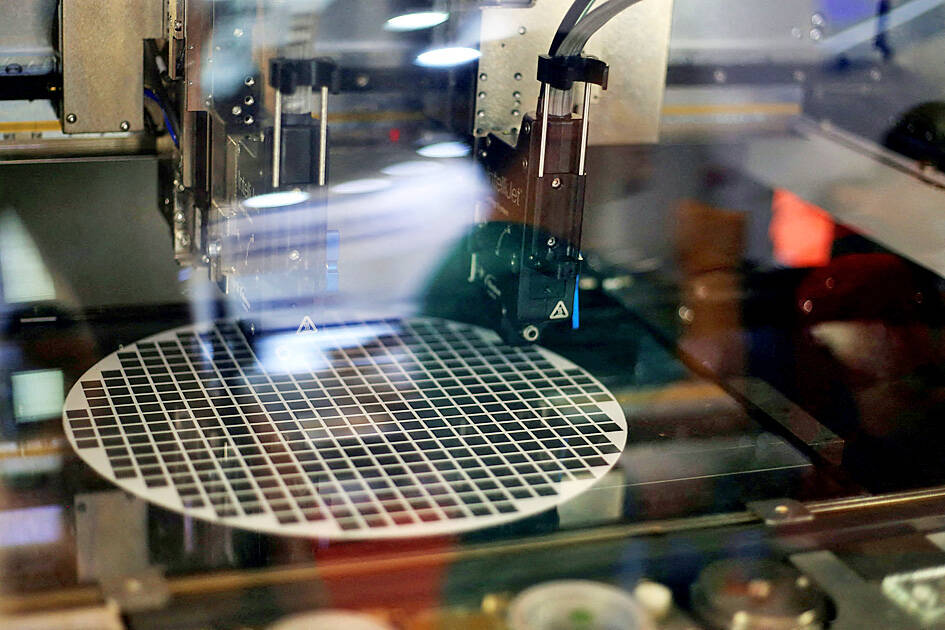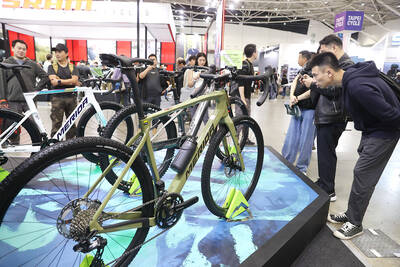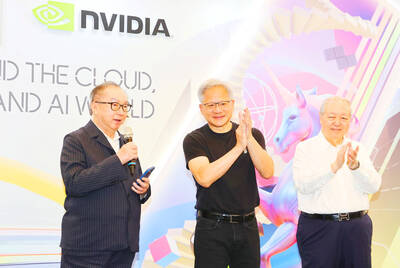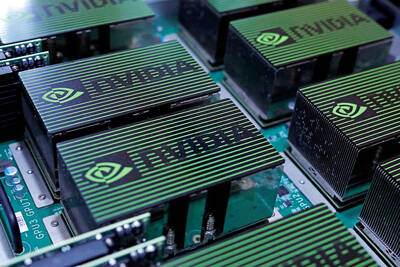Taiwan is expected to be the world’s largest semiconductor fab equipment spender next year at US$23 billion, due to heavy spending by local foundry companies led by Taiwan Semiconductor Manufacturing Co (TSMC, 台積電), international trade group SEMI said yesterday.
Taiwanese chipmakers would spend 4 percent more next year on fab equipment than this year, SEMI said.
Ranking second, South Korea would increase its fab equipment spending by 41 percent to US$22 billion next year to reflect a recovery in demand for memory chips, while spending in China would slide to US$20 billion due to US export controls, SEMI said.

Photo: Reuters
“Despite the constraints, Chinese foundry suppliers and IDMs [integrated device manufacturers] are expected to continue investments in mature process nodes,” it said.
Washington imposed bans on the supply of 14-nanometer and 7-nanometer chipmaking equipment to China last year, aiming to slow China’s advances in technology.
The US is expected to hold steady at fourth spot, with spending jumping 23 percent to a record US$14 billion next year, while Europe and the Middle East would also post record investments, with spending soaring 41.5 percent to US$8 billion next year, SEMI said.
Fab equipment spending in Japan and Southeast Asia would likely increase to US$7 billion and US$3 billion respectively next year, it said.
Global chipmakers would see fab equipment spending rebound by 15 percent next year to US$97 billion to cope with recovering demand for chips used in high-performance computing devices and memory chips following inventory adjustments, it said.
In March, SEMI estimated that fab equipment spending would rise to US$92 billion next year.
By segment, foundry companies would lead semiconductor expansion this year with total investments of US$49 billion, up 1 percent from last year, it said.
Next year, their spending would increase 5 percent to US$51.5 billion, as chipmakers expand capacity in leading-edge and mature process nodes, SEMI said.
Memorychip makers led by Samsung Electronics Co would spend US$27 billion on equipment next year, a 65 percent increase, thanks to a 40 percent raise in spending by DRAM makers and a 113 percent jump in spending by NAND producers, it said.
SEMI president and CEO Ajit Manocha said the decline in equipment investment this year is less serious than expected, while the recovery next year would be better than forecast earlier.
“The trend suggests the semiconductor industry is turning the corner on the downturn and [is] on a path back to robust growth fueled by healthy chip demand,” Manocha said in a statement.
Last year, inventory corrections took a toll on equipment spending with global spending sinking 15 percent annually to US$84 billion, SEMI said.

Leading Taiwanese bicycle brands Giant Manufacturing Co (巨大機械) and Merida Industry Co (美利達工業) on Sunday said that they have adopted measures to mitigate the impact of the tariff policies of US President Donald Trump’s administration. The US announced at the beginning of this month that it would impose a 20 percent tariff on imported goods made in Taiwan, effective on Thursday last week. The tariff would be added to other pre-existing most-favored-nation duties and industry-specific trade remedy levy, which would bring the overall tariff on Taiwan-made bicycles to between 25.5 percent and 31 percent. However, Giant did not seem too perturbed by the

AI SERVER DEMAND: ‘Overall industry demand continues to outpace supply and we are expanding capacity to meet it,’ the company’s chief executive officer said Hon Hai Precision Industry Co (鴻海精密) yesterday reported that net profit last quarter rose 27 percent from the same quarter last year on the back of demand for cloud services and high-performance computing products. Net profit surged to NT$44.36 billion (US$1.48 billion) from NT$35.04 billion a year earlier. On a quarterly basis, net profit grew 5 percent from NT$42.1 billion. Earnings per share expanded to NT$3.19 from NT$2.53 a year earlier and NT$3.03 in the first quarter. However, a sharp appreciation of the New Taiwan dollar since early May has weighed on the company’s performance, Hon Hai chief financial officer David Huang (黃德才)

NVIDIA FACTOR: Shipments of AI servers powered by GB300 chips would undergo pilot runs this quarter, with small shipments possibly starting next quarter, it said Quanta Computer Inc (廣達), which supplies artificial intelligence (AI) servers powered by Nvidia Corp chips, yesterday said that AI servers are on track to account for 70 percent of its total server revenue this year, thanks to improved yield rates and a better learning curve for Nvidia’s GB300 chip-based servers. AI servers accounted for more than 60 percent of its total server revenue in the first half of this year, Quanta chief financial officer Elton Yang (楊俊烈) told an online conference. The company’s latest production learning curve of the AI servers powered by Nvidia’s GB200 chips has improved after overcoming key component

UNPRECEDENTED DEAL: The arrangement which also includes AMD risks invalidating the national security rationale for US export controls, an expert said Nvidia Corp and Advanced Micro Devices Inc (AMD) have agreed to pay 15 percent of their revenue from Chinese artificial intelligence (AI) chip sales to the US government in a deal to secure export licenses, an unusual arrangement that might unnerve both US companies and Beijing. Nvidia plans to share 15 percent of the revenue from sales of its H20 AI accelerator in China, a person familiar with the matter said. AMD is to deliver the same share from MI308 revenue, the person added, asking for anonymity to discuss internal deliberations. The arrangement reflects US President Donald Trump’s consistent effort to engineer